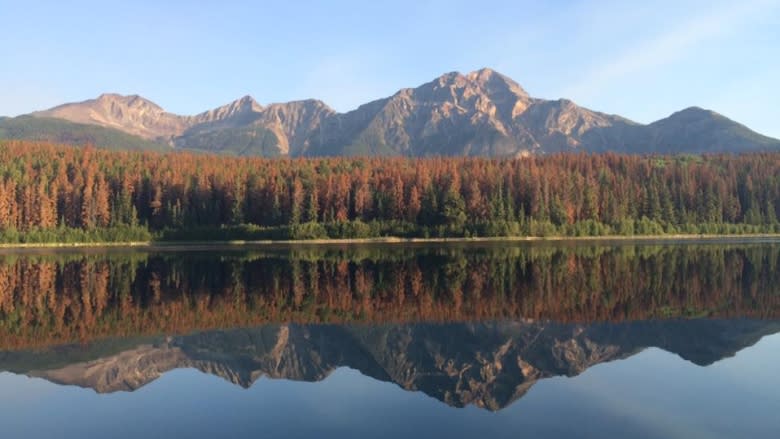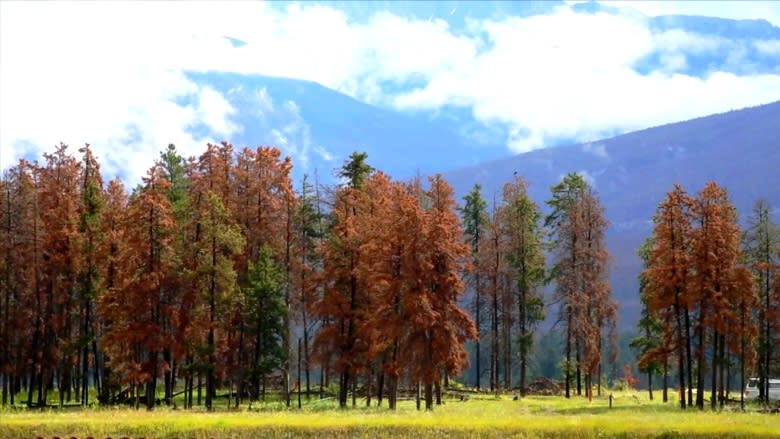Mountain pine beetle turns Jasper forests red, raises fire concerns among residents
The patchwork of green forests in and around Jasper National Park is increasingly interrupted with splashes of red.
It's a sign of destruction caused by the mountain pine beetle and it's more apparent than ever before in Alberta's westernmost forests — altering the landscape that greets visitors to the iconic national park and prompting debate about how to manage the effects of tinder-dry, dead wood near the town site.
"I think it is more in your face," said Bob Covey, the editor, publisher and writer for the Jasper Local.
"You can see it in the valleys that surround the town."
At the restaurant where Covey works part-time, he said visitors will sometimes ask, "What's up with the red trees and the pine beetle?"
The Alberta government has spent hundreds of millions of dollars to stop the spread of the pest. The decade-long efforts have slowed the beetle's movement toward the carefully managed forests that supply wood for lumber and other purposes located to the east of Jasper.
But the national park has been changed forever by the beetle's presence.
"The populations in Jasper have reached an epidemic level and they've been going like that for at least several years," said Allan Carroll, a professor of insect ecology and director of the forest sciences program at the University of British Columbia.
"As a consequence, there are so many beetles that there's not much that can be done and instead, Jasper is just going to have to learn to adapt to a whole bunch of dead pine trees in their forests."
Mountain pine beetle burrow in pine tree bark, releasing a fungus that clogs and destroys the connective tissues of the trees. Trees can die within weeks of an attack. The pines turn red after they have succumbed to the beetles' onslaught.
Carroll says the forests of Jasper won't always be filled with rust-coloured trees. After a few years, the red needles fall off, leaving a grey-coloured tree. The human eye will eventually adjust how it sees the landscape, naturally focusing more on the green shrubs and healthy growth that will surround the dead trees.
"In four, five or maybe 10 years time, it won't be that obvious, except to the trained eye, that there has been an outbreak there at all," he said.
Fire threats top of mind
But in the meantime, some Jasper residents are increasingly worried about not just the esthetics of red, rusty forests, but also the fire hazards that accompany several square kilometres of dry trees.
"The people in Jasper aren't saying they're wondering if the town's going to burn down, it's when the town is going to burn down," said Jasper resident David Millar.
Carroll said the wildfire threat is an expected consequence of pine beetle infestations.
"Killing a bunch of trees means that not far down the road, those trees will be available as fuel for wildfire," he said. "So their biggest focus, once the beetle has run its course, is going to be managing for wildfire."
Christine Nadon, who manages communications for the town of Jasper, said dry conditions are not new for the town and that both the town and Parks Canada are prepared for potential fires.
"This year we've ramped up our training, equipment and collaboration," she said, noting that council has been asked by worried residents to fund more fire protection equipment.
"The public awareness this year is a bit heightened, probably from looking at the red trees around town. That's what drives that uncertainty from residents," she said.
The town is hosting its second wildfire and emergency information session later this week. There was so much demand after an initial session this spring, that the town decided to repeat the information.
Covey, the newspaper editor, thinks the worries of some residents about fire hazards are out of proportion to the actual risks to the town.
"We've got a really amazing suite of resources. And the wildlife experts and vegetation specialists have been doing an amazing job for many years," he said.
"It always has been a forested community that 's susceptible to wildfire," he added. "I don't think the risk has gone up proportionally to the amount of panic that you hear."



